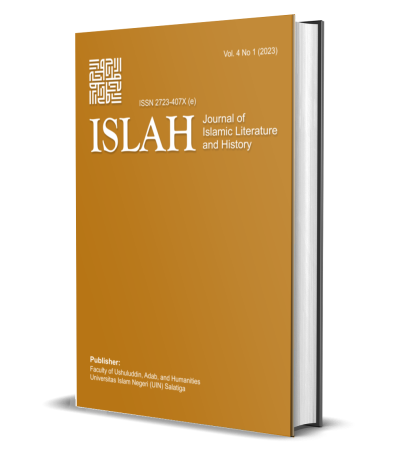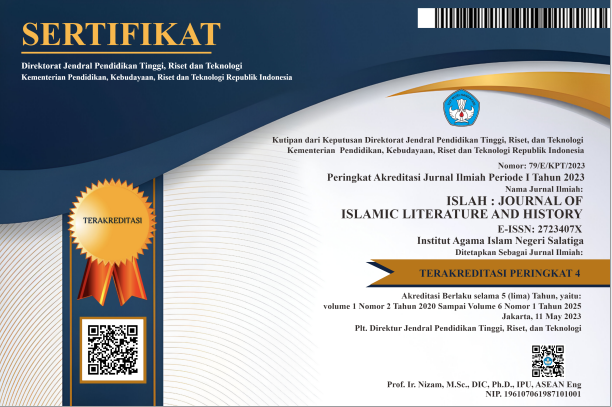Analysis of Language Style in the Syair Dagang by Hamzah Fansuri
DOI:
https://doi.org/10.18326/islah.v6i1.4484Keywords:
Language style, figurative language, diction ,poemAbstract
This study aims to examine the use of figurative language in Syair Dagang by Hamzah Fansuri. Hamzah Fansuri is recognized as one of the prominent literary figures during the golden age of Islamic kingdoms in the Indonesian Archipelago, particularly in 16th century Aceh. The research employs a qualitative method with a descriptive approach. Data were collected through online sources and analyzed using reading and note-taking techniques. The analysis reveals several types of figurative language found in the poem. Four types of figures of speech were identified: metaphor (2 instances), antithesis (1 instance), simile (1 instance), and repetition (5 instances). In addition, 19 significant diction choices were found that enrich the overall meaning of the poem. These findings indicate that Hamzah Fansuri’s use of stylistic elements and diction not only enhances the aesthetic quality of the poem but also deepens its spiritual and philosophical messages.
References
Aini Ulwi Sifa. “Analisis Stilistika Pada Puisi ‘Maqomat Cinta’ Karya Heri Isnaini.” Morfologi: Jurnal Ilmu Pendidikan, Bahasa, Sastra Dan Budaya 1, no. 6 (2023): 18–26. https://doi.org/10.61132/morfologi.v1i6.64.
Annisa, Nur, Teti Sobari, and Woro Wuryani. “Analisis Semiotika Puisi ‘Fatamorgana’ Karya Prilly Latuconsina.” Parole: Jurnal Pendidikan Bahasa dan Sastra Indonesia 1, no. 4 (2022).
Badriyah, Siti. “Pengertian Majas: Fungsi, Macam, dan Contohnya.” Gramedia Blog, n.d. https://www.gramedia.com/literasi/pengertian-majas/?srsltid=AfmBOoou1lRoIYHfnkcvJ9f3lLIt4ieITnSF2tJFCY9LxK2Ni9IUuL03.
Carolina, Gracia. “Pengertian Majas Repetisi dan Contohnya dalam Kalimat.” Zenius Education, Mei 2022. https://www.zenius.net/blog/majas-repetisi-bahasa-indonesia/.
Dahlan, Muhammad. “Analisis Gaya Bahasa dalam Puisi Sajak Bulan Mei 1998 di Indonesia Karya W. S. Rendra.” Jurnal Konsepsi 10, no. 1 (2021).
Dwi, Anugrah. “Jenis-Jenis Majas Dan Contohnya Secara Lengkap.” FKIP UMSU, September 12, 2023. https://fkip.umsu.ac.id/jenis-jenis-majas-dan-contohnya-secara-lengkap/.
Faizun, Mochammad. “Analisis Gaya Bahasa dalam Puisi Ada Tilgram Tiba Senja Karya W.S. Rendra: Kajian Stilistika.” KREDO : Jurnal Ilmiah Bahasa Dan Sastra 4, no. 1 (2020): 67–82. https://doi.org/10.24176/kredo.v4i1.4658.
Gregorian M Irwan Hale and Katharina Woli Namang. “Analisis Gaya Bahasa Dan Amanat Dalam Lagu Ciptaan ‘Derfi Ngara Hale.’” Jurnal Kajian Penelitian Pendidikan Dan Kebudayaan 3, no. 1 (2024): 178–88. https://doi.org/10.59031/jkppk.v3i1.551.
Heryansyah, Tedy Rizkha. “Pengertian Majas, Jenis-Jenis, Dan Contohnya, Lengkap!” Ruang Guru, June 11, 2024. https://www.ruangguru.com/blog/pengertian-jenis-dan-contoh-majas.
Jayanti, Fitri, Surastina, and Dian Permanasari. “Kemampuan Menulis Puisi Modern dengan Menggunakan Media Musik pada Siswa Kelas X SMA Negeri 2 Gedong Tataan.” Warahan: Jurnal Ilmiah Mahasiswa Pendidikan Bahasa dan Sastra Indonesia 4, no. 2 (2022).
Salmaa. “Apa Itu Sastra? Pengertian, Teori, Struktur, Dan Aliran Sastra.” Deepublish, March 1, 2022. https://penerbitdeepublish.com/apa-itu-sastra/.
Salmaa. “Pengertian Syair, Ciri-Ciri, Unsur, Jenis, Dan Contoh Lengkap.” Deepublish, February 21, 2022. https://penerbitdeepublish.com/syair-adalah/.
Salwa, Carissa, Litha Syahfira Maulana, Mita Pratiwi, Muhamad Bahtiarudin, and Indra Rasyid Julianto. “Antropologi Sastra: Kebudayaan yang Terdokumentasikan dalam Karya Sastra.” JURNAL PESASTRA (Pendidikan Bahasa dan Sastra) 2, no. 1 (2025). https://doi.org/10.36709/pesastra.v2i1.87.
Teniwut, M. “Macam Gaya Bahasa Dan Contohnya.” Media Indonesia, January 25, 2023. https://mediaindonesia.com/humaniora/553201/macam-gaya-bahasa-dan-contohnya#goog_rewarded.
Waruwu, Marinu. “Pendekatan Penelitian Pendidikan: Metode Penelitian Kualitatif, Metode Penelitian Kuantitatif Dan Metode Penelitian Kombinasi (Mixed Method).” Jurnal Pendidikan Tambusai 7, no. 1 (2023).
Wikipedia. “Hamzah Fansuri.” https://en.wikipedia.org/wiki/Hamzah_Fansuri.
Downloads
Published
Issue
Section
License
Copyright (c) 2025 cucu nurhayati, R. Myrna Nur Sakinah

This work is licensed under a Creative Commons Attribution-ShareAlike 4.0 International License.
Copyright
Authors retain copyright and grant the journal right of first publication with the work simultaneously licensed under a Creative Commons Attribution-ShareAlike 4.0 International License. In line with the license, authors are allowed to share and adapt the material. In addition, the material must be given appropriate credit, provided with a link to the license, and indicated if changes were made. If authors remix, transform or build upon the material, authors must distribute their contributions under the same license as the original.
Licensing

This work is licensed under a Creative Commons Attribution-ShareAlike 4.0 International License.








